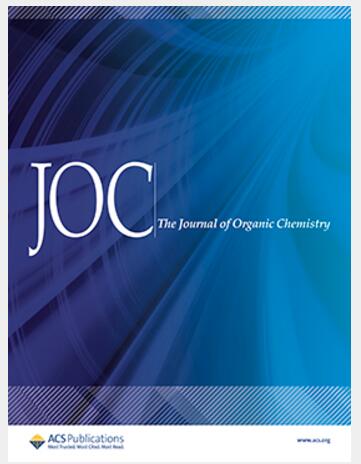绿光下BODIPY荧光的光活化
IF 3.6
2区 化学
Q1 CHEMISTRY, ORGANIC
引用次数: 0
摘要
现有的具有光激活荧光的合成染料需要紫外线辐射,或者最多需要紫光来进行荧光光激活。然而,在这个波长相对较短的范围内照射生物样品会引起明显的光损伤。迫切需要在波长大于500 nm的中等功率密度照射下光化学产生荧光产物的策略,以实现可忽略光毒性的活细胞成像。我们确定了一种可能的结构设计,以满足这些严格的辐照要求。具体来说,我们证明了在可见光谱的绿色区域,硼二吡咯甲烷(BODIPY)发色团的照明会分裂相邻的恶嗪杂环,形成具有红色光谱窗口发射的荧光产物。我们成功地用561 nm的激光光激活了该化合物,并在581 nm的激发下以纳米精度定位了荧光产物的单分子,甚至在活细胞内部。事实上,我们在这种前所未有的光照条件下重建了标记细胞的纳米结构溶酶体的亚衍射图像。我们的研究结果清楚地表明,这种荧光光激活的光化学策略是一种可行的方法,可以实现非常需要的光激活合成染料,用于具有活细胞兼容辐射要求的超分辨率成像。本文章由计算机程序翻译,如有差异,请以英文原文为准。
Photoactivation of BODIPY Fluorescence with Green Light
Existing synthetic dyes with photoactivatable fluorescence demand ultraviolet radiation or, at best, violet light for fluorescence photoactivation. Illumination of biological samples within this range of relatively short wavelengths, however, causes significant photodamage. Strategies for the photochemical generation of fluorescent products under irradiation at wavelengths longer than 500 nm with moderate power densities are urgently needed to enable live-cell imaging with negligible phototoxicity. We identified a possible structural design to satisfy these stringent irradiation requirements. Specifically, we demonstrated that illumination of a borondipyrromethene (BODIPY) chromophore in the green region of the visible spectrum cleaves an adjacent oxazine heterocycle to form a fluorescent product with an emission in the red spectral window. We successfully photoactivated this compound with a 561 nm laser and localized single molecules of the fluorescent product with nanometer precision under 581 nm excitation, even in the interior of live cells. Indeed, we reconstructed subdiffraction images of the nanostructured lysosomes of the labeled cells under such unprecedented illumination conditions. Our results clearly indicate that this photochemical strategy for fluorescence photoactivation is a viable one for the realization of very-much needed photoactivatable synthetic dyes for super-resolution imaging with live-cell compatible irradiation requirements.
求助全文
通过发布文献求助,成功后即可免费获取论文全文。
去求助
来源期刊

Journal of Organic Chemistry
化学-有机化学
CiteScore
6.20
自引率
11.10%
发文量
1467
审稿时长
2 months
期刊介绍:
Journal of Organic Chemistry welcomes original contributions of fundamental research in all branches of the theory and practice of organic chemistry. In selecting manuscripts for publication, the editors place emphasis on the quality and novelty of the work, as well as the breadth of interest to the organic chemistry community.
 求助内容:
求助内容: 应助结果提醒方式:
应助结果提醒方式:


